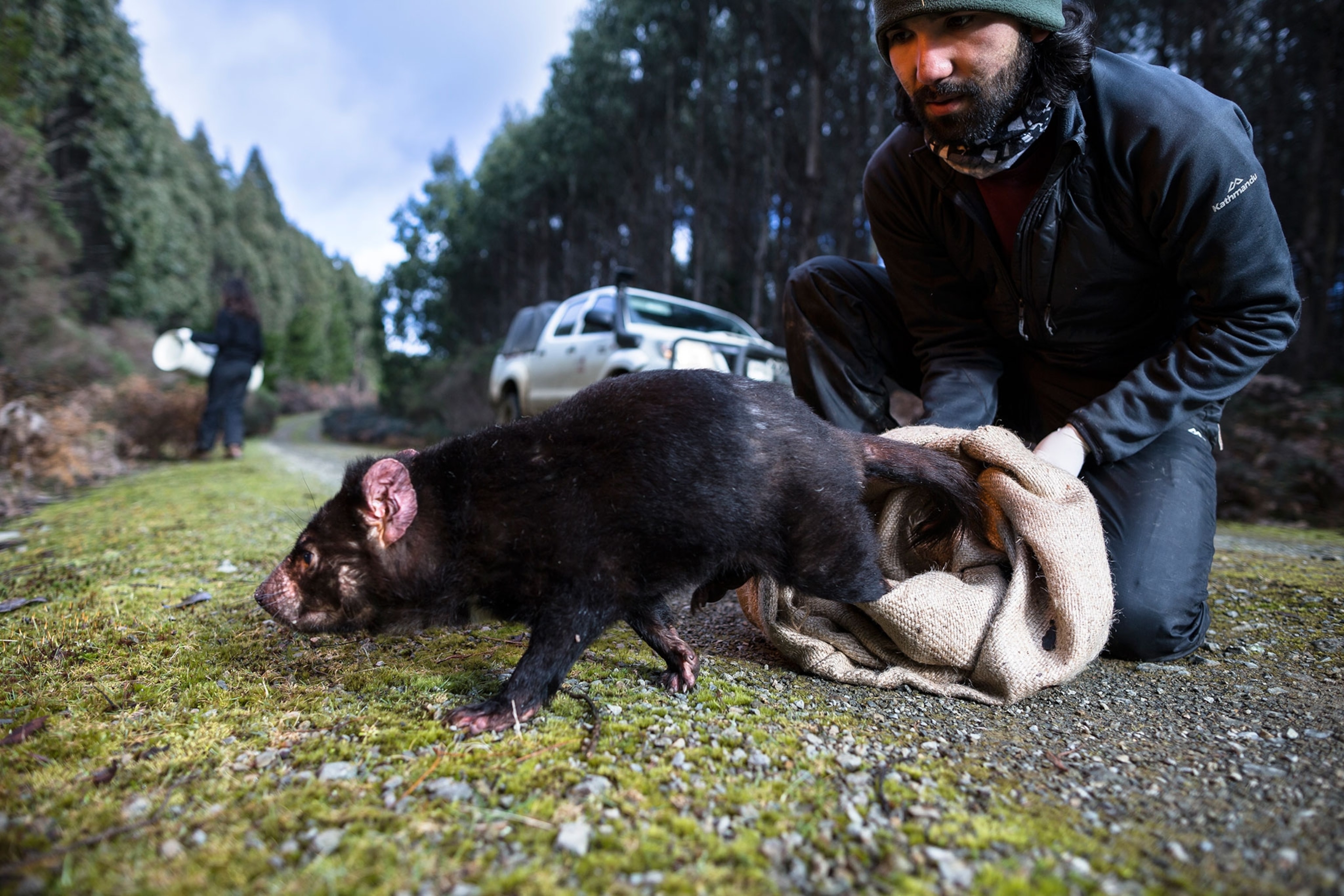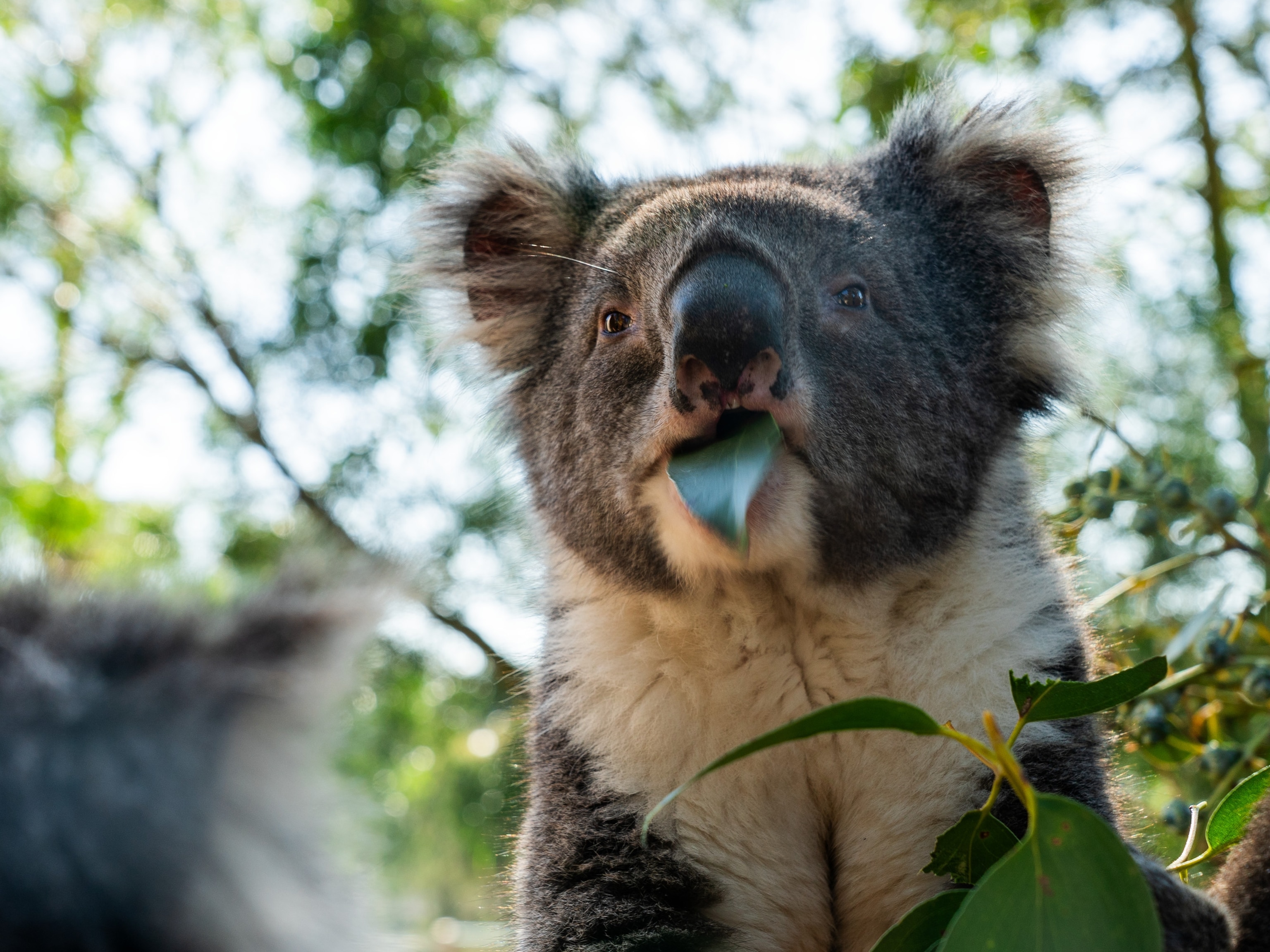
Can Tasmanian Devils Beat Cancer of the Face?
Tasmanian devils looked doomed. But with help from humans—and evolution—they seem to be coming back from a devastating plague.
HOBART, Tasmania — On a small island just off the east coast of Tasmania, south of Australia, a mother Tasmanian devil dozes in the afternoon sun. Her two pups lounge on her back, resting their glossy heads, but scanning their surroundings with interest.
Now they roll off and begin to tussle. Screeching and growling, they nip at each other’s necks and muzzles—playing at the quintessential devil behaviour that in recent decades has threatened to drive the species extinct.
Tasmanian devils are aggressive, carnivorous marsupials. About two feet long, they weigh up to 26 pounds and live about five years, if they’re lucky, which very few are these days. Since the mid-1990s, a bizarre infectious cancer called devil facial tumor disease has swept through the devil population, reducing it from 140,000 to as few as 20,000.
When devils scuffle and bite one another during the mating season, tumor cells from infected animals enter the open wounds of their sparring partners. There the malignant cells grow into massive facial tumors. Infected animals die in about six months, sometimes from starvation—the tumors make it hard for them to eat.

When the disease was first discovered, horrified researchers feared it would take Tasmania’s key native predator over the cliff into extinction, with ripple effects through the ecosystem. During its lifetime a single devil may devour hundreds of brushtail possums, for instance, as well as large quantities of carrion.
But these days researchers are betting the devils will make it through. Disease-free reserve populations have been established, including one on Maria Island, the home of those young pups tussling in the sun. Meanwhile, field trials of a new vaccine against the cancer began in late September.
And most encouraging of all, there are preliminary signs that the devils themselves are adapting to the disease. They may be evolving the ability to beat it.
This One Isn’t Our Fault
Tasmanian devils went extinct on the Australian mainland 400 years ago. Humans probably contributed to their demise, by introducing the dingo for instance. On Tasmania, devils have lost a lot of their preferred habitat—dry eucalyptus forest and coastal scrub—to farms and pastures.
But the epidemic that now threatens them is not human doing. It began when a single devil developed cancer in the 1990s—and, in a far more rare event, when that cancer turned out to be transmissible to other devils. A number of viruses, such as the human papilloma virus, are known to cause cancer, but this disease is different: it’s the cancer cells themselves that are transmitted. Every infected devil has in effect received a tissue transplant from the original cancerous devil. That type of transmission is very rare in animals and occurs in humans only in exceptional situations, such as when an organ with a tumor is surgically transplanted.
Most infectious diseases tend to grind to a halt when population numbers are low, because the animals are too widely spread to infect one another. But the devils’ facial tumors are transmitted during mating, when the animals cover great distances and use all their keen senses to find one another. Their eagerness to mate ensures that nearly every adult devil is exposed.
“They are dead by age three,” says Menna Jones, a devil expert at the University of Tasmania in Hobart. “If they are lucky, they get one litter out.”
Fearing the worst, the state government created the emergency population reserve on Maria Island. The 37-square-mile islet has become a refuge for many native species in Tasmania, including eastern gray kangaroos, Bennett’s wallabies, and the long-nosed potoroo.
They are dead by age three. If they are lucky, they get one litter out.Menna Jones, University of Tasmania
In 2012 and 2013, 28 orphaned and captive-bred devils, all cancer-free, were let loose on the island. Today the population numbers between 80 and 90. Another emergency population was recently started on the Forestier Peninsula, just south of Maria Island. The area was cleared of diseased devils and re-seeded with healthy animals.
A Promising Vaccine
The effort to develop a vaccine that would help devils ward off the disease is centered at the University of Tasmania. In the lobby of the building where immunologist Bruce Lyons and his colleagues work, a display case shows how pressure from the massive tumors can actually deform the animals’ skulls. Upstairs in the lab, one jar of tissue samples is labelled “Stinky”—it’s a name, not a warning. Every devil in the research project has its own nickname. Devils are ferocious animals, but they’re also affecting.
The reason their face cancer is infectious, Lyons explains, is that for some reason the cancer cells have very few of the distinctive molecules on their surface, collectively called MHC, that would allow another devil’s immune system to recognize the cells as foreign. The vaccine researchers thus face the opposite task from transplant surgeons: They’re trying to teach the devils’ immune systems to reject rather than accept foreign tissue.
The new vaccine consists of cancer cells that have been treated with a protein called gamma interferon, which makes them express the MHC molecules at much higher levels. The cells are then killed to render them harmless.

On September 25, 19 immunized devils were released at Narawntapu National Park on Tasmania’s north coast. They were brought to the site in special crates made of plastic tubing, which mimics the smooth, curved surface of their natural burrows, says Samantha Fox of the Tasmanian government’s Save the Tasmanian Devil Program. Many of the devils waited until dark to leave their tubes.
Then, in the silent moonlight, “within about ten minutes, four devils came out of their traps,” Fox says. “They put their noses in the air and sniffed.” In a moment they were gone.
It was an emotional scene for Fox—the first time devils were being released not into an isolated refuge like Maria Island, but into a wild environment, and even one that has been hard hit by the epidemic. “It is a real turning point,” she says. The devils will be periodically monitored, along with any offspring, to see if the vaccine protects them.
Every infected devil has in effect received a tissue transplant from the original cancerous devil.
Bruce Lyons grew up on the north coast and went to Narawntapu for the release. While he was there he took a drive to check out some of his childhood haunts. Along the dirt road that led to his old swimming hole, he saw dozens and dozens of dead animals by the side of the road—evidence that the ecosystem’s chief scavenger has gone missing.
“Normally, they’d be cleared up,” Lyons says, his voice breaking. He takes off his glasses and presses on his eyelids.
Evolution to the Rescue?
Like the population reserves, the vaccination program is merely first aid for a species that had been hurtling toward oblivion—not a long term strategy for re-establishing large, healthy, free-ranging populations of Tasmanian devils. The current version of the vaccine requires four injections over time, which makes it impractical to administer to wild devils scattered over large areas. Even if the researchers could get the vaccine down to one shot, catching every devil on Tasmania would be “a big task,” says Lyons.
But the first evidence is beginning to surface that the Tasmanian devil will ultimately be saved by a force more ingenious and efficient than any conservation plan cooked up by humans: Evolution.
In populations Jones has followed since before the disease outbreak, numbers spiralled downwards for seven years. “Up until 2007 or 2008, every six months I would have said, ‘it is getting worse,” she says. “It really grieved me. You’d walk along and there’d be no tracks and no scat.”
The patterns we are seeing give hope.Menna Jones, University of Tasmania
But now, in research that is still in the early stages, Jones says she is seeing adaptations to the disease. Some devils seem to be able to beat the cancer—either because they’ve evolved resistance to it or because the cancer is evolving toward reduced virulence.
“We’ve seen seven, possibly eight animals whose tumors have regressed,” Jones says. She is trying to determine what distinguishes those animals or those tumors genetically.
Meanwhile, some populations seem to be behaving less aggressively. It’s possible, Jones says, that the cancer is favouring devils who are a bit less devilish—and so run less risk of getting infected.
Whatever the reason, the bottom line is that devil numbers seem to have stabilized, albeit at low levels. “We are getting anecdotal reports that people are seeing devils again,” Jones says. “The patterns we are seeing give hope.”
Follow Emma Marris on Twitter.








